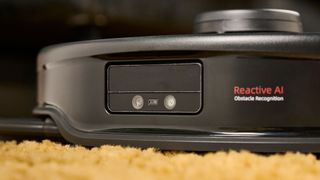LiDAR vs vSLAM: which robot vacuum navigation technology is better?
LiDAR and vSLAM are two of the most popular navigation methods used by today’s best robot vacuums. Working in conjunction with various sensors, they help the robot vacuum find its way around your home. They start by creating an initial map of the space, and then aid in navigation on cleaning runs thereafter. Good navigation ensures your bot cleans your whole floor – with no missed spots – in an efficient way.
LiDAR, or light detection and ranging, uses pulses of light sent from a raised central puck to create a detailed map of a space. It’s perhaps the most popular navigation method for newer robovacs, and is super-accurate and fast. vSLAM – visual simultaneous location and mapping – relies on visual information from the camera to understand the space. It’s typically slower and less efficient than LiDAR.
There are other mapping technologies available, too, although LiDAR and vSLAM are the most common. Some robovacs will combine multiple mapping technologies together; LiDAR bots will still typically feature a camera alongside their navigation puck.
That’s the short explanation; now let’s dig into exactly how LiDAR and vSLAM compare…
What is LiDAR?
LiDAR is used by most high-end robot vacuums. This method uses lasers to measure distances and create a detailed, precise image of an area, and it’s used both for initial mapping and general navigation. Here’s how it works:
- A cluster of beams of light are sent out from a raised puck that’s located in the center of the top surface of the robot.
- It uses a a ToF (time-of-flight) sensor to measure how long it takes for these beams to bounce back.
- This information is used to work out how far away objects in the area are located.
- All the data is collected and used to create a 360-degree map of the room and everything in it.
Pros and cons of LiDAR
In terms of current popular robovac navigation methods, LiDAR is the fastest and most reliable. LiDAR-based robot vacs can be expected navigate in neat lines, to ensure they don’t miss any spots, and won’t often bash into your furniture, either. In most cases, you’ll be able to watch a visualization of your bot making its way around your home in real-time via a companion app.

LiDAR does exhibit a few downsides. One is that this method relies on a raised puck, which makes the robovac taller than it would otherwise be. The shallower your bot, the more ground it will cover around your home – that raised puck might be the difference between the robovac being able to clean underneath your sofa, for instance.
At time of writing, Roborock is about to launch a bot that has a puck that can pop up and down; but otherwise, we haven’t really seen any innovations to counter the issue.
There are also a couple of limitations to how it understands objects. LiDAR treats every obstacle as something solid, so it won’t try to push past a fabric valance to clean beneath your bed or sofa, for example. This issue can be solved by tucking any fabric “barriers” out of the way before sending your bot out to clean. Floor mirrors have also been known to mess with the reflected light beams, causing inaccuracies in mapping. Overall, though, it’s an excellent navigation technology.
What is vSLAM?
vSLAM is less common in modern robovacs, although a notable exception is that all of iRobot’s Roomba bots use it. vSLAM uses visual information from the robovac’s onboard camera to help it create a map of the space and understand its position and orientation within it. You’ll sometimes find vSLAM referred to as “camera-based mapping”.
As major robovac brand Ecovacs explains: “vSLAM gives a robot vacuum the ability to navigate a home using a camera… to capture images of its surroundings and identify specific points, like corners or edges of furniture. The device then uses these points to triangulate its 3D position and create a map of your home.”
Pros and cons of vSLAM
Since vSLAM uses the robot’s camera, there’s no need for it to have that raised central puck (required for LiDAR navigation). That means the bot usually has a shallower profile, and it can clean in areas that might be off-limits to taller robovacs.

Unfortunately, that’s about it for the pros in relation to LiDAR vs vSLAM. vSLAM uses a lot of computational power, which makes it significantly slower and less efficient. It also seems to be less accurate – vSLAM-based bots can have a habit of embarking on illogical cleaning routes and bumping into things as they go.
vSLAM bots can struggle to find their way around if the room isn’t well lit. Many come equipped with an LED headlight to try to counter this, but you may still want to switch on your lights before sending your robovac to clean. This could prove annoying if you want your robovac to clean while you’re out in the day, in spaces that lack natural light. vSLAM-based robovacs can also have a hard time navigating spaces that don’t have many distinguishable features.
LiDAR vs vSLAM: which is better?
For the vast majority of people, LiDAR will prove the superior system. LiDAR navigation is faster and more reliable, with the bot cleaning logically in straight lines. It doesn’t require the room to be well lit to operate effectively, either.
vSLAM navigation is slower and less efficient. The bot can struggle to find its way around dimly lit spaces, or rooms without clear landmarks, and navigation can be convoluted, too. The one benefit of vSLAM over LiDAR is that it doesn’t require a raised central puck, so the robot can be shallower in profile, and potentially able to reach places a LiDAR-based bot cannot.
#LiDAR #vSLAM #robot #vacuum #navigation #technology
